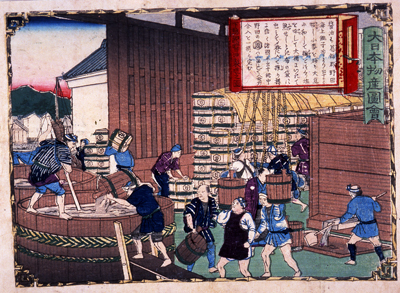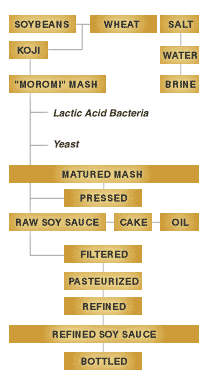Home » Asian for a New Generation » The Story of Soy Sauce

Developed in China more than 2,500 years ago, soy sauce is one of the world’s oldest condiments. Over the centuries, it has remained a cornerstone of many Asian cuisines. And today, chefs in the West recognize it as a natural, all-purpose seasoning that promotes balance among ingredients.

While studying in China, a Japanese Zen priest came across this new seasoning made from fermented soybeans. Upon returning to Japan, the priest began making his own version and introducing it to others. Over the years, the Japanese improved and refined the soy sauce, eventually adding wheat in equal proportion to the soybeans to create a mellower, more balanced flavor.
By the 1600s, soy sauce began to resemble the product we know today. It was at this time that the Kikkoman story began in the town of Noda, Japan, not far from present-day Tokyo, when the founding families of the Kikkoman Corporation began brewing soy sauce.
Kikkoman Soy Sauce is brewed slowly and aged for full flavor like a fine wine, just as soy sauce has been made for 2,500 years.
The result is a soy sauce that is both remarkably complex and extraordinarily simple: complex because it contains more than 300 individual flavor components and well-balanced amino acids that give it a distinctive flavor and bouquet; and simple because it is made from just four natural ingredients—water, wheat, soybeans and salt—transformed through fermentation.
At Kikkoman, the soy sauce production process begins with the selection of the finest soybeans and wheat. Next, a proprietary culture starter, or seed mold, is introduced and the mixture is allowed to mature. The resulting culture, or koji, is then transferred to fermentation tanks, where it is mixed with a brine solution to produce a mash called moromi. Then Kikkoman adds the most important ingredient of all: time. Despite advances in technology, the fermentation process simply cannot be hurried. It takes six months for the full flavor, color and aroma of the soy sauce to develop.


The difference is clear: Non-brewed soy sauce (far left) is often opaque, with a harsh, overpowering flavor and a pronounced chemical aroma. Traditionally brewed soy sauce (left) is transparent, with a light amber color and a balanced flavor and aroma.
What’s critical to the chef in selecting a soy sauce is the difference in taste and performance between traditionally brewed and non-brewed soy sauces. Traditionally brewed soy sauce has a mellow, sweet-salty flavor, a subtle aroma and a delicate, transparent color—qualities that marry well with the flavors and colors of other ingredients.
Non-Brewed Soy Sauce
Not all soy sauces are traditionally brewed. Non-brewed or “chemically produced” soy sauces are the result of a 20th-century “shortcut” process known as acid hydrolysis, which takes only a few days.
First, soybeans are boiled with hydrochloric acid for 15 to 20 hours. After the soybeans yield their maximum amount of amino acids, the mixture is cooled. The amino acid liquid is then pressed through a filter, mixed with active carbon and purified through filtration. Caramel color, corn syrup and salt are typically added to this hydrolyzed vegetable-protein mixture. Finally, the mixture is refined and packaged.
The harsh, salty, chemical flavor of opaque non-brewed soy sauce is one-dimensional; it masks and overpowers other ingredients. One San Francisco chef put it best: “I liken it to the difference between swallowing moonshine and sipping a 1947 cognac.”
Hyde Park, NY Location
1946 Campus Dr. | Hyde Park, NY 12538
Maps & Directions
Napa, CA Location
500 First Street | Napa, CA 94559
Maps & Directions
Singapore Location
21 Tampines Ave 1 Block 31 | Singapore 529757
Maps & Directions
St. Helena, CA Location
2555 Main St. | St. Helena, CA 94574
Maps & Directions
San Antonio, TX Location
312 Pearl Pkwy, Bldg 3 | San Antonio, TX 78215
Maps & Directions